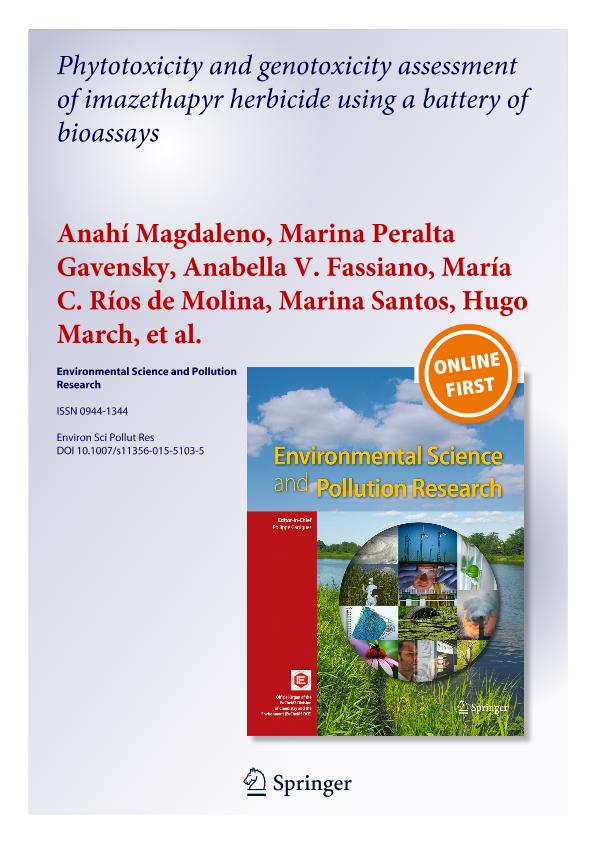Artículo
Phytotoxicity and genotoxicity assessment of imazethapyr herbicide using a battery of bioassays
Magdaleno, Anahí ; Peralta Gavensky, Marina
; Peralta Gavensky, Marina ; Fassiano, Anabella Victoria
; Fassiano, Anabella Victoria ; Rios, Maria del Carmen
; Rios, Maria del Carmen ; Santos, Marina; March, Hugo; Moretton, Juan Agustin; Juárez, Angela Beatriz
; Santos, Marina; March, Hugo; Moretton, Juan Agustin; Juárez, Angela Beatriz
 ; Peralta Gavensky, Marina
; Peralta Gavensky, Marina ; Fassiano, Anabella Victoria
; Fassiano, Anabella Victoria ; Rios, Maria del Carmen
; Rios, Maria del Carmen ; Santos, Marina; March, Hugo; Moretton, Juan Agustin; Juárez, Angela Beatriz
; Santos, Marina; March, Hugo; Moretton, Juan Agustin; Juárez, Angela Beatriz
Fecha de publicación:
12/2015
Editorial:
Springer Heidelberg
Revista:
Environmental Science and Pollution Research
ISSN:
0944-1344
e-ISSN:
1614-7499
Idioma:
Inglés
Tipo de recurso:
Artículo publicado
Clasificación temática:
Resumen
The imazethapyr herbicide (formulation Verosil®) was evaluated for phytotoxicity and genotoxicity using a battery of bioassays: (1) the growth inhibition of the green alga Pseudokirchneriella subcapitata, (2) the root growth and germination of the higher plant Lactuca sativa, (3) the genetic damage using the Salmonella/microsome test, and (4) the aneugenic and clastogenic effects on Allium cepa. The Verosil® formulation was highly toxic to the non-target green alga (median effective concentration (EC50) = 1.05 ± 0.05 mg active ingredient (a.i.) L−1), and concentrations above 10 mg a.i. L−1 inhibited root elongation in lettuce: relative growth index (RGI) between 0.28 ± 0.01 and 0.66 ± 0.10. No genotoxic effect was observed in Salmonella typhimurium at 100 mg a.i. L−1, either with or without the microsomal fraction. However, significant differences in the frequency of chromosomal aberrations in anaphases and telophases (bridges, chromosome fragments, and vagrants) were observed in A. cepa at concentrations between 0.01 and 1 mg a.i. L−1 with respect to the control. The frequencies of micronuclei showed significant differences with respect to the control at concentrations between 0.001 and 0.1 mg a.i. L−1. A very high mitotic index (MI = 93.8 ± 5.8) was observed associated with a high number of cells in the prophase stage at 100 mg a.i. L−1, indicating cytotoxicity. These results showed that imazethapyr is toxic to the non-target populations in both aquatic and terrestrial ecosystems. This herbicide might also exert clastogenic and aneugenic mitotic damage in higher plants. Therefore, the imazethapyr formulation may constitute an environmental risk to plants.
Archivos asociados
Licencia
Identificadores
Colecciones
Articulos(IQUIBICEN)
Articulos de INSTITUTO DE QUIMICA BIOLOGICA DE LA FACULTAD DE CS. EXACTAS Y NATURALES
Articulos de INSTITUTO DE QUIMICA BIOLOGICA DE LA FACULTAD DE CS. EXACTAS Y NATURALES
Citación
Magdaleno, Anahí; Peralta Gavensky, Marina; Fassiano, Anabella Victoria; Rios, Maria del Carmen; Santos, Marina; et al.; Phytotoxicity and genotoxicity assessment of imazethapyr herbicide using a battery of bioassays; Springer Heidelberg; Environmental Science and Pollution Research; 22; 23; 12-2015; 19194-19202
Compartir
Altmétricas



